 |
| How Do Organisms Reproduce- ClassX- CBSE |
Also Read: Life Process- PREVIOUS YEAR QUESTIONS FROM CBSE EXAMS
Very Short Answer Type
Questions
Ans: Reproduction is one of the most important characteristics of living beings because :
- it is essential for existence and continuity of a species.
- it helps to pass genetic information to next generation.
- it brings variations in next generation which is the basis for evolution.
Ans: Differences between binary fission and multiple fission are as follows:
| Binary fission | Multiple fission |
| (i) The parent organism, splits to form two new organisms, e.g., Amoeba, Paramecium. | The parent organism splits to form many new organisms at the same time, e.g., Plasmodium. |
| (ii) The nucleus of the parent body divides only once to produce two nuclei. | The nucleus of the parent body divides repeatedly to produce many nuclei. |
Ans: The four modes of asexual reproduction are :
- binary fission
- budding
- regeneration and
- vegetative propagation.
Short Answer Type Questions
Ans: Plasmodium and Leishmania reproduce by the process of fission which is an asexual mode of reproduction. Plasmodium reproduces by multiple fission. About 1000 daughter cells are produced by the multiple fission of a Plasmodium. Leishmania reproduces by the process of binary fission. In Leishmania, the splitting of parent cell takes place in a definite plane (longitudinally) with respect to flagellum at its end to produce two daughter cells.
The three conditions favourable for spores to germinate and grow are moisture, suitable temperature and food (nutrition).
Ans: Difference between asexual and sexual mode of reproduction is as follows :
Asexual reproduction: Gametes are not formed hence fertilisation does not take place.
Sexual reproduction: Gametes are always formed and fertilisation takes place to form a zygote.
Species reproducing sexually has a better chance of survival as variations occur only during the sexual reproduction. Variations increase the chances of survival of an individual by making them more fit. Selection of variations by environmental factors forms the basis of evolution.
Q4. Explain the term “regeneration” as used in relation to reproduction of organisms. Describe briefly how regeneration is carried out in multicellular organisms like Hydra. (AI 2016)
Ans: The process of formation of entire organism from the body parts of a fully differentiated organism is called regeneration. It occurs by process of growth and development.
Simple animal like Hydra shows regeneration. When a small piece of Hydra breaks off it grows into complete new Hydra.During regeneration, the cells of cut body part of the organism divide rapidly to make a mass of cells. The cells here move to their proper places within the mass where they have to form different types of tissues. In this way complete organism is regenerated.
Ans: The main differences between fission and fragmentation are as follows:
| Fission | Fragmentation |
| (i) Occurs in unicellular organisms. | Occurs in multicellular organisms. |
| (ii) Body of organism divides by mitotic divisions into two or more daughter cells. E.g., Leishmania. | Body of the organism splits into one or more fragments and each fragment forms a complete organism. E.g., Spirogyra. |
Ans:
| Pollination | Fertilization |
| 1. Definition. It is transfer of pollen grains from anther to the stigma of a flower. 2. Step. Pollination precedes fertilization. 3. Purpose. It carries the male gamete producing pollen grains to the female sex organ. 4. Process. Pollination is a physical process. 5. Occurrence. It occurs only in seed plants. | It is the fusion of male and female gametes. Fertilization occurs only after pollination when the pollen grain has germinated and male gametes are carried into ovule. It actually brings about fusion of gametes. Fertilization is a physico-chemical (biological) process. It occurs in both plants and animals of various types. |
Ans:
| Pollination | Fertilization |
| 1. Definition. It is transfer of pollen grains from anther to the stigma of a flower. 2. Step. Pollination precedes fertilization. 3. Purpose. It carries the male gamete producing pollen grains to the female sex organ. 4. Process. Pollination is a physical process. 5. Occurrence. It occurs only in seed plants. | It is the fusion of male and female gametes. Fertilization occurs only after pollination when the pollen grain has germinated and male gametes are carried into ovule. It actually brings about fusion of gametes. Fertilization is a physico-chemical (biological) process. It occurs in both plants and animals of various types. |
(b) Write the functions of secretions of prostate çland and seminal vesicles in humans. (CCE 2013)
Ans:
(a)
Testis —> Epididymis —> Vas deferens —>Urinogenital duct
(b) Both the glands produce semen plasma, 60—70% by seminal vesicles and 20—30% by prostate gland. It is required for activation and transport of sperms.
Ans: Definition: Variation is differences in structure, physiology and other characters found in the individuals of the same organism.
Benefits of variations to species.
Many of the variations are pre-adaptations which have no immediate benefit to the individuals. However, they remain in the population. Whenever, environment undergoes a drastic change, the pre-adaptations present in some members of the population allow the latter to survive, grow and regain its former size. Therefore, it is not necessary that variations are beneficial to individuals developing them but can prove useful to the species.
- seminal vesicles and
- prostate gland.
(b) List two functions performed by testes in human beings. (CBSE A.I. 2008, 2009, CCE 2013)
Ans: (a)
- Seminal Vesicles: They secrete 60-70% of semen plasma that is alkaline and viscous having fructose (for nourishing the sperms), fibrinogen, proteins and prostaglandins. Prostaglandins cause movements in the genital tract of the female. Sperms are also activated by secretion of seminal vesicles.
- Prostate Gland: It produces 20-30% of semen plasma. The secretion is alkaline and viscous. It has clotting enzyme and chemical essential for sperm activity.
(b) Function of Testes,
- Formation of sperms from germinal cells of seminiferous tubules.
- Secretion of testosterone by Leydig cells present in the connective tissue in between the seminiferous tubules.
Ans: Reproduction: Reproduction is the process of producing new young individuals of similar type by the mature individuals.
Importance of DNA Copying.
Types. Asexual reproduction and sexual reproduction.
New Characteristics: New characteristics appear only in sexual reproduction due to
- Chance separation of chromosomes during meiosis required for gamete formation,
- Crossing over during meiosis.
- Chance coming together of chromosomes during fertilization,
- Mutations or mistakes during DNA replication.
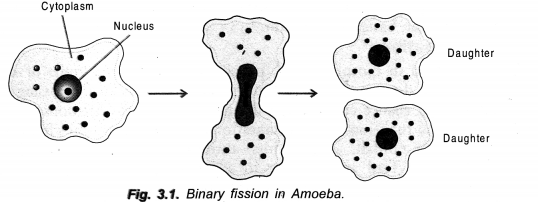
(b) How do oral pills prevent pregnancy ? (CCE 2011)
Ans:
(a)
- Gonorrhoea caused by bacterium Neisseria gonorrhoeae
- Syphilis caused by bacterium Treponema pallidum.
(b) Oral pills contain progestin (= progesterone) alone or in combination with estrogen. They prevent pregnancy by inhibition of ovulation, making uterine wall unsuitable for implantation alongwith unsuitable changes in cervical mucus and activity of fallopian tubes.
Q13. A student is observing a permanent slide showing sequentially the different stages of asexual reproduction taking place in yeast. Name this process and draw diagrams of what he observes in a proper sequence. (CBSE A.I. 2016)
Answer:Budding.
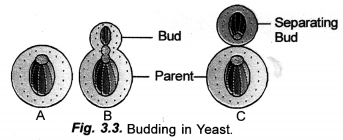
(ii) Placenta (Foreign 2011)
Ans: (i) Implantation of zygote refers to the process of attachment of the blastocyst on the inner wall of the uterus, It occurs on 7th day after fertilisation and is controlled by estrogen and progesterone hormones.
Long Answer Type Questions
(CBSE Delhi 2006, 2016, CCE 2011, CBSE Foreign 2016)
Ans: Pollination: The transfer of pollens from anther to the stigma of a flower is called pollination.
Types: There are two types of pollination— self pollination and cross pollination.
Differences:
Self Pollination | Cross Pollination |
| 1. Flowers. It is the transfer of pollen grains from anther to stigma of same or genetically similar flower. | It is the transfer of pollen grains from the anther of one ‘ flower to the stigma of another flower. |
| 2. Pollen. Pollen grains are produced in small number. | Pollen grains are produced in large number. |
| 3. Agency. An external agency is not required. | An external agency is required for carrying of pollen grains from one flower to another. |
| 4. Variations. It does not produce variations. | It brings about a lot of variations. |
| 5. Vigour. There is a slow loss of vigour in self pollinated plants. | Vigour of the plants is maintained. |
| Ex. Commelina, Viola, Wheat. | Ex. Salvia, Bottle Brush, Bombax. |
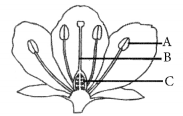
Ans:
In the given figure, part A is anther, part B is style and part C is ovule.
Anther (A) is a part of male reproductive organ of flower called stamen. Large number of pollen grains are formed inside anther. Style (B) and ovule (C) are parts of female reproductive organ of flower called carpel / pistil.
Style is a long conducting tube which gives the passage to pollen tube carrying male gametes so that it reaches ovary which contains one or more ovules. Ovules contain female gamete or egg. On fertilisation ovary converts into fruit and ovules give rise to seeds.
Q3. (a) What is fertilization ? Distinguish between external fertilization and internal fertilization.
(b) What is the site of fertilization in human beings ? (CBSE Delhi 2007)
Ans:
(a) Fertilization: The union of male gamete (sperm) with the female gamete (ovum) to form a diploid zygote is called fertilization.
Differences Between External and Internal Fertilization.
External Fertilization | Internal Fertilization |
| 1. Place. Fertilization occurs outside the body of the female. | Fertilization occurs inside the body of the female. |
| 2. Release of Gametes. Both the sexes discharge their gametes outside their body. | Only the male discharges the gametes and that also in the reproductive tract of the female. The female retains its gametes. |
| 3. Surety. It is not a sure method. | It is a sure method of fertilization. |
| 4. Embryo. Embryo develops unprotected, outside the body of the female. | Embryo is generally well protected but may develop outside or inside the body of the female. |
| Examples. Fishes, Amphibians. | Examples. Reptiles, Birds, Mammals, Insects, Spiders. |
(b) Site of Fertilization. Ampulla part of fallopian tube.
Q4. Explain double fertilization in plants. (CBSE A.I. 2007)
Ans: Definition. The phenomenon of two male gametes fusing with different cells in the same embryo sac to produce two different structures is called double fertilization.One male gamete fuses with oosphere (egg) to form diploid zygote. It is called generative fertilization. Zygote grows to form embryo. The second male gamete fuses with diploid secondary nucleus of central cell. It produces a triploid primary endosperm cell. The fusion is called triple fusion or vegetative fertilization. It produces a nutritive tissue called endosperm.
Ans: (a) One egg is produced every month by one of the two ovaries in a human female. Fertilization occurs inside the fallopian tube (ampulla isthmus junction).
(b) If the egg is not fertilized, it lives for one day and is then expelled. This also sets in motion the menstrual cycle. After about 12 days the corpus luteum (empty Graafian follicle) degenerates. In the absence of hormones progesterone and estrogen, the glandular part of endometrial lining is peeled off alongwith discharge of blood and mucus. The process is called menstruation. It lasts for 3-5 days.
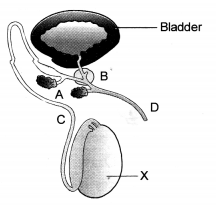
(a) Label A and B
(b) Name the hormone produced by X. What is the role of this hormone in human male ?
(c) Mention the name of substances that are transported by tubes C and D.
(CCE 2011)
Ans: (a) A —seminal vesicle
B — prostate gland.
(b) X— testosterone. Testosterone controls sperm formation, expression of secondary characters and functioning of accessory glands.
(c) C— sperms.
D — semen (including sperms) and urine.
Ans:Three contraceptive methods which can help to control human population are:
(i) Condom : It is a mechanical barrier which does not allow sperms and ovum to meet, hence prevents fertilisation. Condoms are made of thin rubber/latex sheath used to cover the penis in the male and vagina/cervix in female just before coitus (intercourse) so that the ejaculated semen is not released in the female reproductive tract.
(ii) Intrauterine devices (IUDs): These are devices inserted by doctors or expert nurses in the uterus through vagina. These are presently available as non-medicated IUDs, copper releasing IUDs (CuT, etc.) and hormone releasing IUDs. They increase phagocytosis of sperms within uterus and suppress sperm motility and its fertilising capacity. They also make uterus unsuitable for implantation and cervix hostile to sperms.
(iii) Oral pills : These pills contain progesterone alone or a combination of progestogen and estrogen. They inhibit ovulation and make uterus unsuitable for implantation, hence prevent fertilisation.
Q8. (a) List two reasons for the appearance of variations among the progeny formed by sexual reproduction.
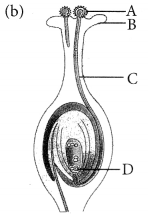
(i) Name the part marked A in the diagram.
(ii) How does A reaches part B?
(iii) State the importance of the part C.
(iv) What happens to the part marked D after fertilisation is over? (AI 2016)
Ans: (a) Variations arise in sexually reproducing organisms on account of the following:
(i) Genetic variations occur of because DNA copying mechanism is not absolutely accurate.
(ii) Creation of new combinations of genetic variations because variations from two individuals combine during fusion of gametes.
(ii) Part B is stigma. It is the part of pistil (female reproductive organ) that receives pollen grains. Pollen grains reach stigma through various agencies like wind, water, insect, etc.
(iii) Pollen tube (C) carries male gametes to the ovule present in ovary. Male gametes fuse with egg and secondary nucleus to give rise to zygote and endosperm.
(iv) Female gamete (D) fuses with male gamete and converts to embryo after fertilisation.
Ans: The four methods of birth control which deliberately prevent fertilisation in humans are:
- Barrier method- These are physical devices to prevent the entry of sperm in the female, e.g., condoms.
- Chemical method – It involves the use of oral pills that check ovulation. These are mainly hormonal preparations and contain estrogen and progesterone.
- Intrauterine contraceptive device-These devices are implemented into uterus, e.g., copper – T, to prevent fertilisation.
- Surgical methods : These methods involves removal of a small jJortion of vas deferens in males or fallopian tube in females to prevent fertilisation. Contraception prevents frequent pregnancies and sexually transmitted diseases thus supports good health and prosperity of a family.
Effects:
- Enjoying a good reproductive health.
- Protecting from sexually transmitted diseases.
- Restricting the number of children.
- Spacing the birth of children so as to properly look after them, provide them proper education without depleting the resources of the family.
- Controlling population.
Ans: The general awareness regarding reproductive health in a society is significant as :
- Maintenance of personal hygiene among youngsters and proper knowledge of their reproductive parts helps them adjust with the physical changes and cope with emotional disturbances.
- Reproductively healthy society must be free from the curse of child marriage which begets many complications at the level of individual and society both.
- Proper care of expecting mothers, monitoring their health after child birth and care of new born help in building a healthy society.
- Married couples aware of contraceptive methods lead a better married life as they are capable of avoiding unwanted pregnancies and have negligible chances of contracting sexually transmitted diseases.
In past 50 years, various areas related to reproductive health have been launched which have improved the reproductive health of our society in following ways: Two of them are :
(i) reduced mortality rate of mother and infant
(ii) birth control due to easily available contraceptive and reduced STDs cases.
Q11. What is placenta? Explain its function in humans. (Foreign 2015, AI 2014)
Ans: Placenta is an intimate connection between fetus and uterine wall of the mother to exchange the materials. It is a disc shaped structure embedded in the uterine wall. It contains villi on embryo’s side and blood spaces towards mothers side. Blood spaces surround villi.
Placenta performs the following functions:
- All nutritive elements from maternal blood pass into the fetus through it.
- Placental helps in respiration, i.e., supply of oxygen and removal of CO2 from fetus to maternal blood.
- Fetal excretory products diffuse out into maternal blood through placenta and are excreted by mother.
- Placenta also secretes hormone.
(b) Why has Government of India prohibited prenatal sex determination by law? State its benefits in the long run.
(c) Unsafe sexual act can lead to various infections. Name two bacterial and two viral infections caused due to unsafe sex. (2020)
Ans: (a) Three different categories of contraceptive methods are :
(i) Barrier methods, i.e., use of condoms, etc.
(ii) Chemical methods, i.e., use of oral pills or vaginal pills.
(iii) Surgical methods, i.e., vasectomy and tubectomy.
(b) Prenatal sex determination was banned in India in 1994. This was done to prevent sex selective abortion. It is being used to kill the normal female fetus. This killing of the unborn girl child is called female feticide which is reducing the number of girls drastically in some societies of our country. Due to reckless female feticide, male-female sex ratio is declining at an alarming rate. Its benefit in the long run is that the female-male ratio could be maintained for a healthy society.
(c) Bacterial diseases due to unsafe sex are gonorrhoea, syphilis.
Viral diseases due to unsafe sex are AIDS, genital herpes.
Q13. (a) In the female reproductive system of human beings, state the functions of:
(i) Ovary
(ii) Oviduct.
(b) Mention the changes which the uterus undergoes, when
(i) it has to receive a zygote.
(ii) no fertilisation takes place.
(c) State the functions of placenta. (2020)
Ans: (a) (i) Tire ovaries in female are primary sex organs (or female gonads) which perform the dual function – production of female gametes (eggs or ova) and secretion of female sex hormones (estrogen and progesterone).
(ii) Oviducts or fallopian tube are paired tubes originating near to the ovaries of their respective sides and extend upto uterus. The terminal part of fallopian tube is funnel-shaped with finger-like projections called fimbriae lying near ovary. Fimbriae pick up the ovum released from ovary and push it into fallopian tube. Fertilisation also takes place in the oviduct.
(b) (i) As the ovary releases one egg every month, the uterus also prepares itself, every month to receive fertilised egg by making its lining thick and spongy to nourish the zygote if fertilisation takes place.
(ii) When the female gamete/egg is not fertilised, this lining is not needed any longer. So, the lining slowly breaks and comes out through vagina as blood and mucus through menstrual cycle that takes place every month.
(c) Placenta performs the following functions :
- All nutritive elements from maternal blood pass into the fetus through it.
- Placenta helps in respiration i.e., supply of oxygen and removal of CO2 from fetus to maternal blood.
- Fetal excretory products diffuse out into maternal blood through placenta and are excreted by mother.
- Placenta also secretes hormone.
(b) Write in proper sequence the processes going on in the different organs of the reproductive system of a human female starting from the time of egg production to childbirth. (2020)
Ans: (a) Two reasons of using contraceptive methods by married couples are :
(i) They prevent frequent or unwanted pregnancies.
(ii) They prevent the transfer of sexually transmitted diseases (STDs).
(b) The female germ cells or eggs are made in ovaries. They are also responsible for the production of some hormones. When a girl is born, the ovaries already contain thousands of immature eggs on reaching puberty.
Some of these start maturing, one egg is produced every month by one of the ovaries. The egg is carried from the ovary to the womb through a thin oviduct or fallopian tube. The oviducts unite into an elastic bag-like structure known as uterus. The uterus opens into the vagina through the cervix. The sperms enter through vagina passage during sexual intercourse. They travel upwards and reach the oviduct where they may meet the egg. The fertilised egg, the zygote gets implanted in the lining of uterus and starts dividing. The mothers body is designed to undertake the development of the child. So, the uterus prepares itself every month to receive and nurture the growing embryo. The lining thickens and is richly supplied with blood to nourish the growing embryo.
After implantation, a disc-like special tissue develops between the uterus wall (called uterine wall) and the embryo (or fetus), which is called placenta. The fetus is connected to placenta in mothers body through umbilical cord. It is through the placenta that all the requirements of the developing fetus like nutrition, respiration and excretion, etc., are met from the mothers body. The development of the child inside the mothers body takes approximately nine months. The child is born as a result of rhythmic contractions of the muscles in the uterus.
Q15. Name the two types of mammalian gametes. How are they different from each other. Name the type of resproduction they are involved in. Write the advantage of this type of reproduction. (CBSE Foreign 2017)
Ans: Mammalian Gametes. Male-Sperm, Female-Ovum.
Differences: Male gamete or sperm is smaller, dart-like motile gamete with scanty amount of food reserve. Female gamete or ovum is larger, rounded, non-motile gamete with a good amount of reserve food. The difference helps the ovum to get loaded with cytoplasmic contents and allow the sperm to swim freely upto the ovum.
Advantages:
- Variations. Due to reshuffling of chromosomes and crossing over, variations appear in almost all characters,
- Adaptability and Evolution. Variations help the organisms to develop adaptability to changes in environment. Their accumulation can also lead to formation of new species.
(CBSE A.I. 2017)
Ans: Definition: Vegetative propagation is the formation of new plants by using vegetative parts of a parent plant as propagules e.g., stem (Sugarcane, Bougainvillea, Potato), root (Sweet Potato, Dahlia), leaf (Bryophyllum), bud (Agave).
Advantages:
- It is the only known method of multiplication of seedless plants like Banana and Sugarcane.
- It is a quicker method as vegetatively reproduced plants bear flowers and fruits earlier than plants raised through seeds.
- All the individual plants are clones of one another and their parent so that the crop is genetically uniform.
- Good quality of a variety can be maintained indefinitely.
Disadvantages:
- There is little adaptability to changes in envrionment.
- Diseases contracted by a parent spread to all the daughters.
Nutrition for Growing Embryo. The contact region between embryo and endometrium grows into placenta. Placenta helps the embryo in obtaining nourishment (and oxygen) from blood sinuses of the uterus.
When Egg is not Fertilized: Glands present in the mucosa of uterine endometrium begin to degenerate. This sloughs off the endometrial lining, releasing a lot of mucus and blood. It is called menstruation. Menstruation lasts for 3-5 days.
(b) Rhizopus
(c) Planaria
(d) Plasmodium
(e) Spirogyra
(f) Bryophyllum. (CCE 2014)
Ans:
(a) Amoeba. Binary fission.
(b) Rhizopus. Spore formation or sporulation
(c) Planaria. Regeneration
(d) Plasmodium. Multiple fission,
(e) Spirogyra. Fragmentation
(f) Bryophyllum. Vegetative reproduction by foliar buds.
Ans: “significance of Sexual Reproduction”
- Due to reshuffling of chromosomes and crossing over, sexual reproduction brings about variations in almost all characters so that no two individuals are similar. Variations are essential for recognition, individuality and competitiveness. They may not protect individuals under adverse conditions but survival of species depends upon pre-adaptive variations.
- Better Adaptability. Increased variability due to sexual reproduction is helpful to organisms in better adaptability to changes in environment.
- Vigour and Vitality. It maintains the vigour and vitality of the individuals.
- Harmful Traits. Harmful traits are often kept suppressed because of reshuffling of gene pairs that occurs during gamete formation and fusion.
- Near Uniformity of Population. Due to the flow of genes amongst individuals during sexual reproduction, the uniformity of population is maintained where there is a broad resemblance of all the individuals with one another.
- Genetic changes brought about by sexual reproduction play an important part in evolution of new forms.
(b) Mention function of each of these parts. (CCE 2012)
Answer: (a)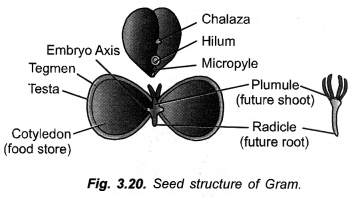
(b)
- Radicle: It forms the first root of the seedling,
- Plumule: It grows to form the shoot of the seedling,
- Cotyledon: It stores food and supplies the same to embryo axis for its growth.
.png)

